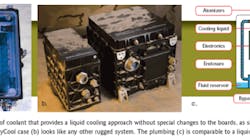Military hardware tends to be rugged by default and design. With the help of two new innovations, these tools can tackle hostile environments like deserts, high altitudes, and combat zones, ensuring reliability and ease of use as well as the safety of the personnel using them.
The first innovation, a spray cooling technology from SprayCool, works without special modifications to the electronics. The second, a set of standards from VITA, effectively allows coax and fiber-optic I/O to be moved to the backplane. This may not sound like much, but front-panel interfaces for these kinds of interfaces normally require manual cable connections. A backplane connection means a board can be reliably swapped out in a matter of minutes, which is key when time is a critical factor.
SPRAY COOLING IS ALL WET
SprayCool’s technology is designed to bring the performance of liquid cooling to a larger audience (see "Military And Avionics Applications Demand Rugged Hardware"). Liquid cooling typically requires special custom heatsinks that must be connected together so the cooling liquid can remove heat from the heatsink.
The SprayCool approach retains most of the aspects of a liquid cooling system but eliminates the need for custom heatsinks (Fig. 1). The coolant pump, heat exchanger, and some of the pipes or tubing remain, but the pipes and tubing aren’t required for individual boards. Instead, the boards are contained in a sealed case. This tends to be an advantage since rugged systems are normally sealed anyway.
Coolant from the pump is sprayed into the case onto the boards, where it cools the electronics. The coolant then enters one or more of the drain holes, where the pump sucks it back into the system. Gravity is usually used to get the coolant to the intakes. This typically means multiple intakes on the bottom of the save. Holes on the top or sides can be included if the device will be used in different orientations such as in an aircraft.
The coolant is not an electrical conductor, so spray cooling can work with off-the-shelf boards. This is a significant advantage when it comes to board design. It also makes it easier when swapping a board/line replaceable unit (LRU).
MOVING COAX AND FIBER TO THE BACKPLANE
The VITA Standards Organization hosts a range of standards that are typically used in military environments, including the venerable VME board standard and the latest VPX (VITA-46) board standard. Currently, the group is evaluating the VITA-67 Analog/RF Interconnect standard (Fig. 2) and the VITA-66 Fiber Optic Interconnect (Fig. 3) standard.
Boards based on the technology will probably show up later in 2010. Understanding why these standards are important and why they will have a significant impact on system design only requires a look at two related issues: cabling and cooling.
Prior to the standards, coax and fiber connections were found on the front panel. This made LRU designs more complex since swapping a board requires cable disconnect/connect. It additionally impacts cooling considerations because of the placement and type of connectors.
Moving the connectors to the backplane connectors simplifies board design, improves cooling, and makes replacement a simple board swap. Backplane connectors with four and eight connections are defined.

